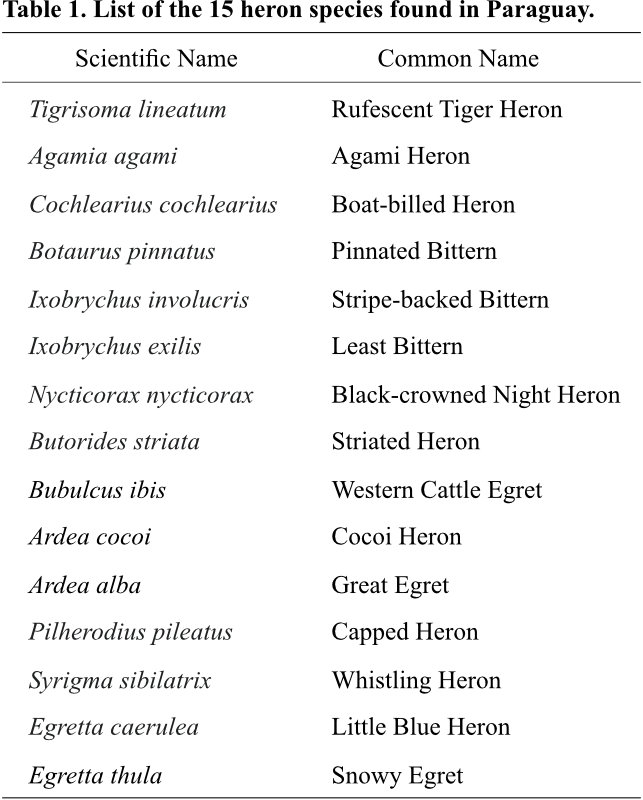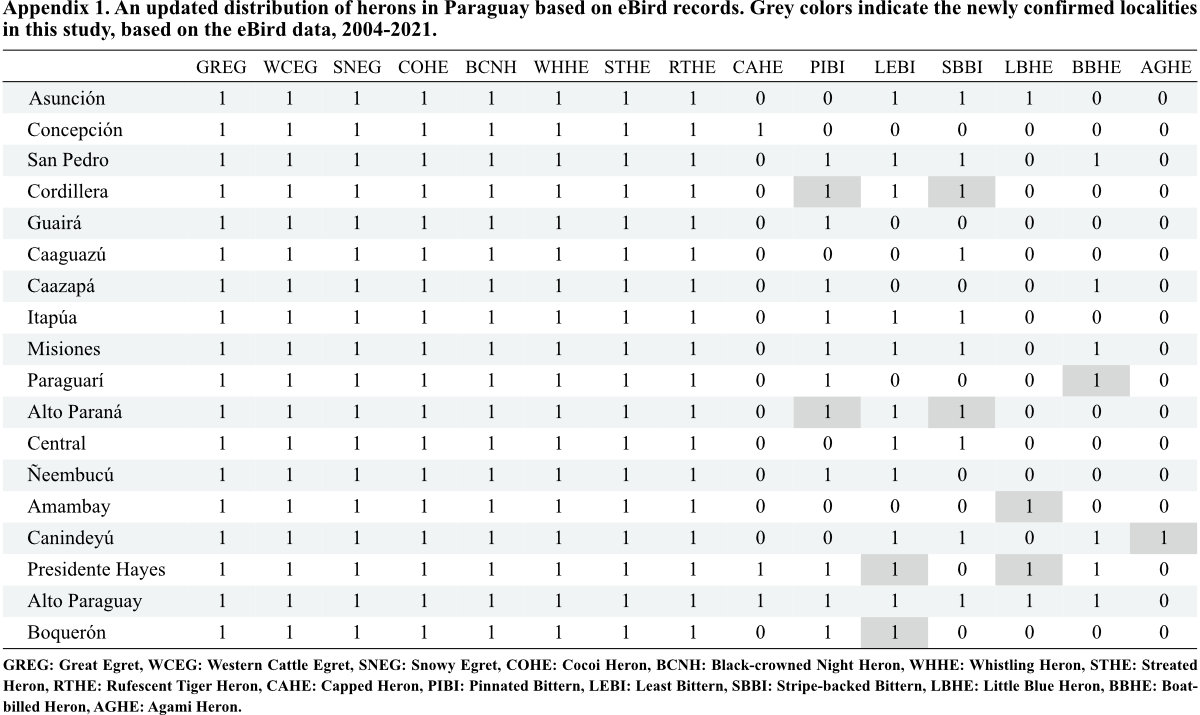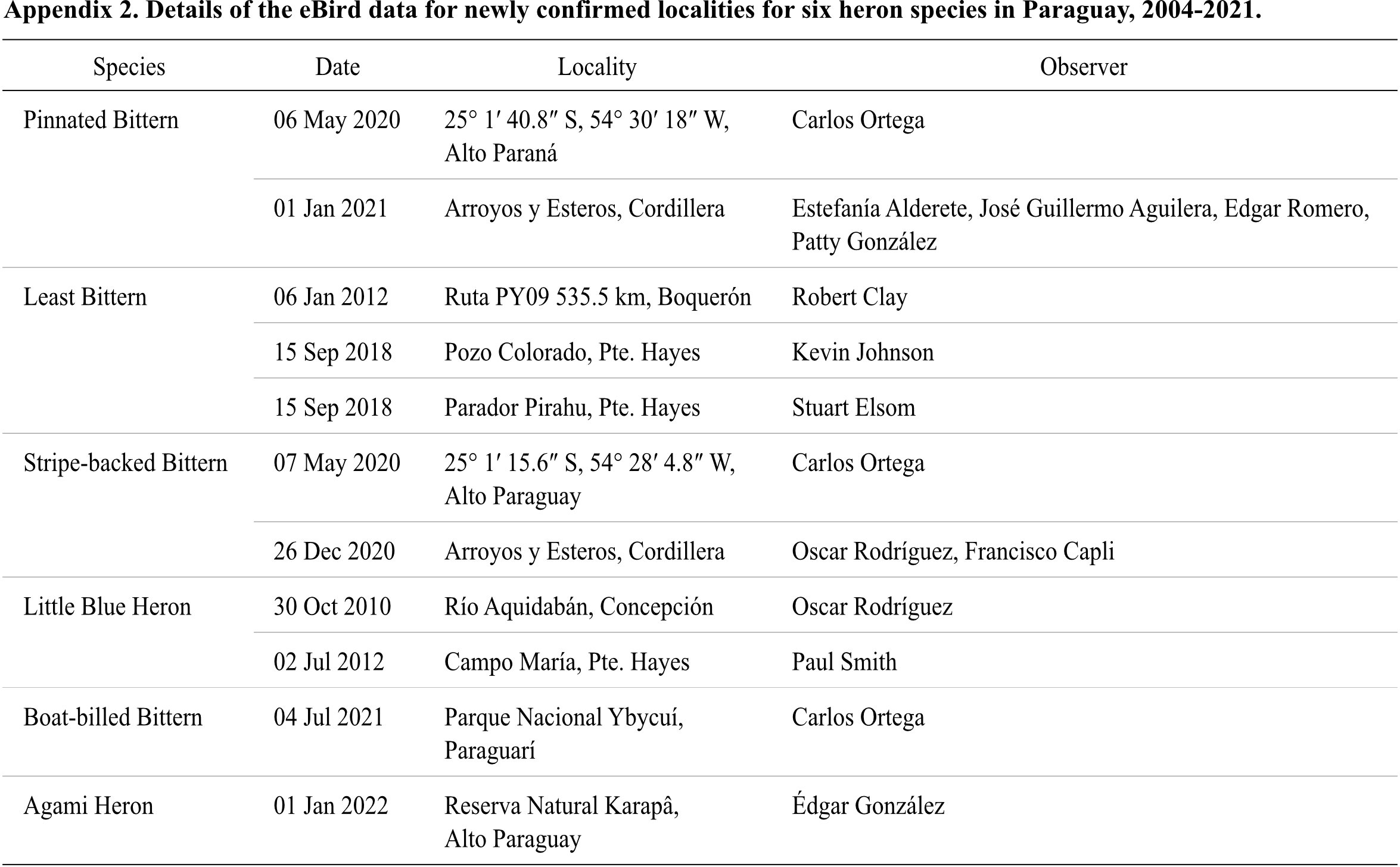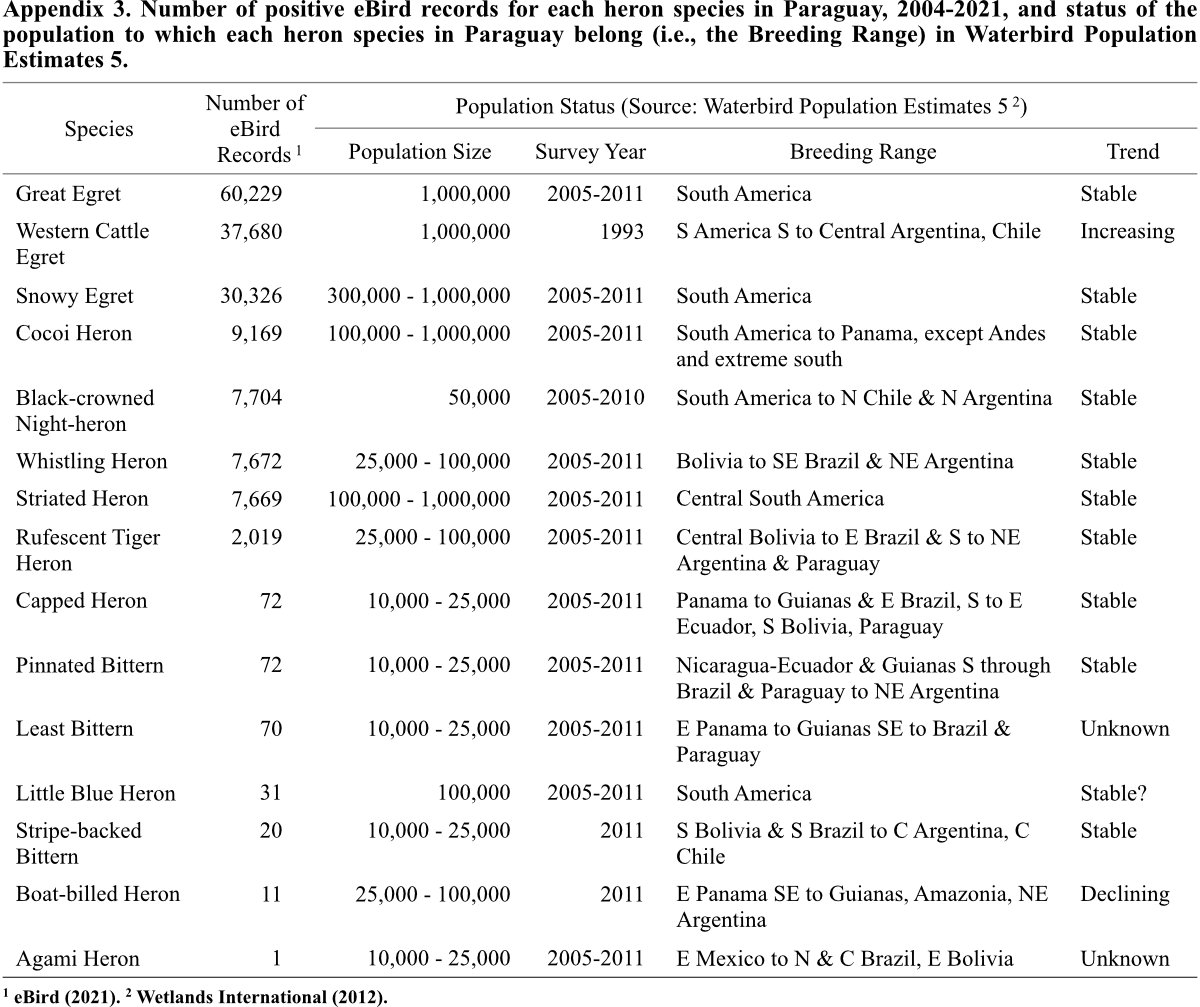Citizen science updates on the occurrence and conservation of herons in Paraguay #
Abstract
The objective of this study was to update our knowledge on the occurrence and conservation of herons in Paraguay, primarily through the use of the Citizen Science platform of eBird and the Neotropical Waterbird Census. The 15 species of herons that occur in Paraguay have been surveyed since 2001, through the Neotropical Waterbird Census (NWC or CNAAs as known in Spanish). From 2015 to 2021, there has been an increase in survey effort through the promotion of the eBird citizen science platform. Data from Paraguay were collected from both of these sources. We extracted data for the 15 heron species occurring in Paraguay from 2004 to 2021 noting the heron records, the number of volunteers and checklists and other information, mainly reported from eBird. This information was complemented by the data from the NWC. The results showed two remarkable groups of herons based on their records, i.e., species with more than 1,000 records reported and those with less than 100 records reported. The three most numerous herons were Great Egret (Ardea alba), Western Cattle Egret (Bubulcus ibis) and Snowy Egret (Egretta thula). The three least numerous herons were Little Blue Heron (Egretta caerulea), Stripe-backed Bittern (Ixobrychus involucris) and Boat-billed Heron (Cochlearius cochlearius). Ten new species-localities were also discovered. In January 2022, outside of the NWC, an Agami Heron (Agamia agami), a new species for Paraguay and a Vulnerable species on the IUCN red list, was recorded in a protected area. The creation of volunteer groups in the country and the development of awareness materials on waterbirds in Paraguay is highlighted. There are still challenges to overcome, such as increasing the numbers of observers outside the country's capital and training on the proper and more rigorous use of the eBird platform. The eBird platform is a tool that many countries could use to update the status of their waterbirds.
Key words: Agamia agami, eBird, Neotropical Waterbird Census, waterbirds.
# This paper was presented at the virtual Symposium on Herons of World-wide Conservation Concern held on 9 November 2021.
Introduction
Birds represent the biological group whose conservation status has been better evaluated compared to other taxa. This is because they are easy to record, found in almost all ecosystems and there are numerous bird watchers around the world that contribute useful data. The data obtained in this way are also helpful as bioindicators of the quality of their habitats, and those of waterbirds, including herons, are especially useful because of their close association with aquatic environments. Due to their fidelity to their nesting site and the predictability of their reproductive phenology, they are also good indicators of environmental change (Kushlan 1993, Hayes 1996, BirdLife International 2022a). However, since birds are a group that responds quickly to environmental changes, their biological parameters need to be reassessed continuously to provide an up-to-date evaluation of their conservation status.
Paraguay holds 123 species of waterbirds, of which 15 (12.2%) are herons (Narosky and Yzurieta 2006) (Table 1). They occur in wetlands of local and international importance, such as those found in the south of the country, the capital, the Central Chaco and the Paraguayan portion of the Pantanal; thus, embracing diverse ecosystems at the national level. However, various threats to these wetlands (and birds) are increasing within these ecosystems, for example, the conversion of wetlands to rice crops and other uses, and the construction of infrastructure works that directly affect these wetlands.

In Paraguay, voluntary semi-annual monitoring has been carried out, since 2001, through the Neotropical Waterbird Census (NWC) by the BirdLife International partner for the country (Guyra Paraguay), and this is the first national citizen science experience led by this ornithological institution. Since 2015, local observers have begun to use the eBird platform extensively as a recording tool and to identify several of the latest records of new species for the country, including herons, as well as updates of their distribution. This tool has enabled a much broader participation by local observers.
In this research, we evaluated the occurrence and distribution of herons, during 2004-2021 and quantified the number of volunteers who participated in the NWC for that period and additionally we used the eBird platform from 2015 to 2021 with more structured volunteer information. Also, we comment on the conservation status of herons, considering their population trends and the quantity of eBird records during the NWC.
Methods
To assess and provide updated information on the conservation status of herons in Paraguay from the citizen science contribution, we focused mainly on the two available sources, eBird and NWC, the latter is now integrated into eBird. We searched eBird records (eBird 2021) at the national level, and extracted information on all records for herons in Paraguay since 2015.
The eBird database was filtered for the years 2004-2021, where all counts defined as present (marked with X on the eBird checklist) were counted as 1. Repeated records on the same day and location were filtered.
We quantified the number of volunteers (citizen scientists) who contributed information to eBird and the NWC that is carried out twice a year (February and July) based on eBird (2021) and Galluppi and Riveros (2020a, b), respectively.
In addition, we re-examined the threat categories at the national and international levels according to Ministerio del Ambiente y Desarrollo Sostenible (MADES) (2019), HeronConservation (2012), International Union for Conservation of Nature (IUCN) (2021) and Wetlands International (2012). To update the new localities or distribution sites, the records were compared with the bird guides of Paraguay, the Atlas de Aves del Paraguay (del Castillo and Clay 2004, 2005) and other references (eBird 2021, Narosky et al. 2022) prior to the new records to assess expected sightings in their known ranges.
Results and Discussion
The number of eBirders and checklists have increased since 2015 with a slowdown during the second part of 2018 and 2019; since then both parameters have increased considerably (Fig. 1). The highest number of checklists was 994 in October 2020 and the highest number of users was 120 in May 2020. This means that the number of checklists and users increased by 12.4 times and 12.0 times, respectively, compared to the 80 checklists and 10 users in January 2015.

Comparing the eBird database of Paraguay with the existing resources on the birds of Paraguay (e.g., del Castillo and Clay 2005, Narosky et al. 2022), we found six heron species have added new localities to the distributions: the Pinnated Bittern (Botaurus pinnatus) and the Stripe-backed Bittern (Ixobrychus involucris) in Cordillera and Alto Paraná, the Least Bittern (Ixobrychus exilis) in Presidente Hayes and Boquerón, the Little Blue Heron (Egretta caerulea) in Amambay and Presidente Hayes, the Boat-billed Heron (Cochlearius cochlearius) in Paraguarí and the Agami Heron (Agamia agami) in Canindeyú (Appendices 1, 2). There are two records groups, one with more than 1,000 records, and one with less than 100 records, in which these species are the more range-restricted species (Fig. 2).



The Little Blue Heron is a vagrant species in Paraguay with no clear pattern of occurrence and the censuses may not have captured its presence in the country. For Pinnated, Stripe-backed and Least Bittern, we know little about their ecology and preferred habitat quality, even though the literature cites that they prefer rushes, swamps and marshes. Also, these species are quite cryptic and difficult to see, unlike other herons, and could have been underestimated. Continuing with habitat preference, the Boat-billed Heron prefers streams in forests, suggesting a very specific habitat preference. In addition, it is quite cryptic and difficult to see in this type of ecosystem. The availability of this type of habitat could be a limitation for the reporting of this species, as well as the opportunity to see it (del Castillo and Clay 2004, 2005, Narosky et al. 2022).
Considering our database, there are no heron species in a threat category at the national or international level among the species recorded during the NWC in Paraguay from 2004 to 2021. However, two species, Least Bittern and Agami Heron, have an “Unknown” trend and Boat-billed Heron has a “Decreasing” trend on their populations (Appendix 3).

In January of 2022, outside of the period for the NWC, an Agami Heron (Agamia agami), a Vulnerable species on the IUCN red list (IUCN 2021), was recorded in a riparian forest at “Reserva Natural Carapâ” (ITAIPÚ Binacional 2022, Martínez et al. 2023, Fig. 3); the site is a binationally managed protected area between Paraguay and Brazil. It is a solitary heron, rarely seen in humid tropical lowlands; its preferred habitat is along streams in forests and locally in mangroves. This is the southernmost record of the species, because its normal distribution range is up to 500 km from northern Paraguay (BirdLife International 2022b, eBird n.d.).

Conclusions and Recommendations
This study has confirmed the presence and widespread distribution of Paraguay’s heron species. It has also listed new localities for six of Paraguay’s herons. Stronger conservations actions for protecting natural habitats in wetlands other than forest is a need. The importance of strengthening national policies to adequately protect wetlands is necessary for the conservation of these species.
The creation of formal birdwatching volunteer groups throughout the country and the development of awareness materials on waterbirds in Paraguay is needed. There are still several challenges to overcome, such as increasing the numbers of well-trained observers outside the country’s capital and implementing the more rigorous use of the eBird platform.
Also, there are opportunities to be developed, such as the use of these platform in designing standard participatory methodologies in which observers can contribute to make better decisions related to conservation and environmental education.
Although one of the 15 herons (the Agami Heron) recorded in the country is currently under a Vulnerable conservation status at the international level, the ones that have few records in recent years (and have decreasing or unknown population trends) are also severely in need of an update in their conservation status. Further work to take actions for protection and conservation of these species could be supported through the contribution of Citizen Science.
Literature Cited
BirdLife Internacional. 2022a. Estado de conservación de las Aves del Mundo. Enfoques y soluciones para la crisis de la biodiversidad. [online] Accessed 20 November 2023.
BirdLife International. 2022b. Species factsheet: Agamia agami. [online] Accessed 20 November 2023.
del Castillo, H. and R. P. Clay. 2004. Lista comentada de las Aves de Paraguay. Annotated checklist of the Birds of Paraguay. Guyra Paraguay, Asunción, Paraguay.
del Castillo, H. and R. P. Clay. 2005. Atlas de las Aves del Paraguay. Guyra Paraguay, Asunción, Paraguay.
eBird. 2021. eBird basic dataset. Version: EBD_rel Jul-2021. Cornell Lab of Ornithology, Ithaca, New York, U.S.A.
eBird. n.d. Agami Heron. [online] Accessed 20 November 2023.
Galluppi, T. and C. Riveros. 2020a. Experiencia con el uso de eBird en Paraguay. Asociación Guyra Paraguay, Asunción, Paraguay.
Galluppi, T. and C. Riveros. 2020b. Censo Neotropical de Aves Acuáticas en el Paraguay. Asociación Guyra Paraguay. Asunción, Paraguay.
Hayes, F. 1996. Seasonal and geographical variation in resident waterbird populations along the Paraguay river. Hornero 14: 14-26.
HeronConservation. 2012. Conservation status of heron population. HeronConservation. [online] Accessed 20 November 2023.
International Union for Conservation of Nature. 2021. The IUCN Red List of Threatened Species. Version 2021-3. [online] Accessed 20 November 2023.
ITAIPÚ Binacional. 2022. Registran avistamiento de una nueva especie de ave en Reserva de Itaipú. [online] Accessed 20 November 2023.
Kushlan, J. K. 1993. Colonial waterbirds as bioindicators of environmental change. Colonial Waterbirds 16: 223-251.
Martínez, V., A. Benítez, E. Frutos, C. Aguilar, G. Tremaine, J. Deichmann, E. González and M. Velázquez. 2023. Contribución al conocimiento de avifauna de la Reserva Natural Carapã y el Refugio Biológico de Mbaracayú, Paraguay con la adición de una nueva especie para el país. Nótulas Faunísticas - Segunda Serie 354 (2023): 1-9.
Ministerio del Ambiente y Desarrollo Sostenible. 2019. Resolución N° 254/2019. “Por la cual se actualiza el listado de especies protegidas de la Vida Silvestre de la Clase Aves”. [online] Accessed 20 November 2023.
Narosky, T. and D. Yzurieta. 2006. Guía para la identificación de las aves del Paraguay. 1a ed.- Buenos Aires:Vázquez Mazzini Editores, Buenos Aires, Argentina.
Narosky, T., H. Del Castillo, R. Clay and D. Yzurieta. 2022. Guía para la identificación de las Aves del Paraguay. 2da ed. Vazquez Mazzini Editores, Buenos Aires, Argentina.
Wetlands International. 2012. Waterbird Population Estimates. Fifth edition. Wetlands International. [online] Accessed 20 November 2023.



